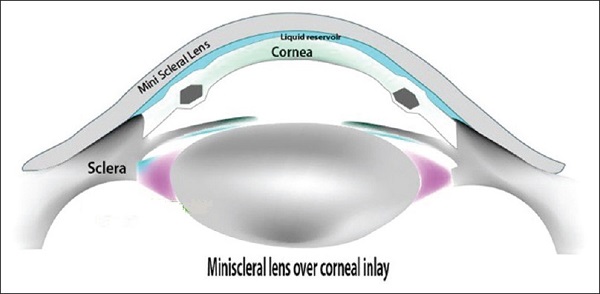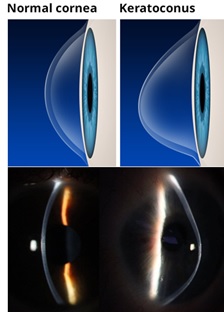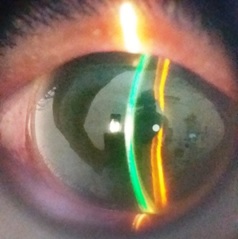
Mini Scleral Device (MSD) and Corneo Scleral Device (CSD) – A boon to those who have Keratoconus and similar corneal irregularities!
On a bright sunny day, Manas (name changed) aged 35 years, walked into Jaya Eye Care Centre for an eye checkup. He had this strange mannerism; he was seen squeezing his eyes while watching TV in the waiting hall and was frequently blinking his eyes. This appeared more like winking as he was closing his left eye more than right. Any non-medical person could tell that something was wrong with his eyes and surely he was not comfortable.
It appeared that he had something in his eye that was bothering him. Upon examination, it was found that he had Keratoconus. There was a small corneal hard contact lens on his left eye, which explains his winking!
Manas had known about his condition since he was 13 years old and has ever since living with seeing things distorted. He remembers rubbing his eyes a lot during his childhood, most of the time hiding behind curtains because he was asked not to.
“My mom had eyes all over her head!” he recalls. He remembers visiting multiple hospitals, eye clinics, and optical shops with his mom in search of the best glasses. “More than me my mom was desperate to make me read clearly what my teacher wrote on the blackboard” he claimed.
As a child he never could enjoy the beauty of nature, read story books which he was very fond of or enjoy watching TV. He was extremely sensitive to sunlight as well as artificial lights during nights. He used to love playing a traditional Tamil Nadu game called “Noorankuchi” that requires concentration and clear vision.
However, because of his poor vision he was never able to win this game and soon had to give up playing. His other favorites were carrom board game and badminton all of which he gave up as he grew older. At school he managed to learn well because of his sharp listening skills and was always good in his studies. He also completed a degree in Physiotherapy with a first-class score.
When he was about 23 years old, he had to undergo a corneal surgery called Deep Anterior Lamellar Keratoplasty (DALK) in his left eye as the keratoconus had progressed significantly and even the best institutes could not find a suitable contact lens that would stay on his eye.
After surgery, his vision improved well with glass correction. However, it was nothing close to normal. He had always seen ghosting of images even with the best optical correction. “Probably that is why I am not scared of ghosts” he humored.
Few months had passed and by this time the keratoconus in his right eye progressed with scar formation and unfortunately, no contact lens was fitting on his right eye. This is when he decided to try contact lens on his left eye so he could manage his everyday activities with one eye. As he had assumed, his vision in left did improve well with contact lens and from that day onwards he has been seeing only with his left eye.
But there was irritation with this lens and he was always living with a fear of losing the lens. He almost gave up the thought of seeing with both eyes together.
Ever since he was in college, he has been passionate about driving. He proudly announced, “I have driven all cars. You name it and I have driven it! But only in broad day light. I had never imagined driving cars to travel long distances with my eye condition”.
About 6 months ago he was very thoughtful about why his life has become this, why he has been depending on others to travel and why can’t he think of driving again. His desperation took a positive turn when he found that MSDs could be a solution for him following an internet search. That was when he visited Jaya Eye Care Centre and he was surprised to note that he was given the same option to try MSDs. He most willing agreed to try them.
For those who don’t know, Keratoconus is a condition where there is progressive thinning of the cornea in both eyes. This results in the cornea re-shaping itself like a ‘cone’. Hence it got its name, Kerato meaning cornea, and Conus meaning cone. Usually, one eye is affected more than the other eye.
Typically, such patients have distorted vision due to the presence of ‘irregular astigmatism’. Many other conditions can result in irregular astigmatism. Some of them are Pellucid marginal degeneration, Keratoglobus, Peter’s Anomaly, Steven Johnson’s syndrome, Estasia in post corneal refractive surgery, Post Radial Keratotomy, Post corneal keratoplasty, Post INTACs, Post C3R treatment, Post-traumatic corneal scarring, Post healed corneal ulcer, Post healed chemical injury etc.
Most of the times such patients are fitted with rigid contact lenses to correct irregular astigmatism. However, many patients drop out from wearing them due to lack of comfort with such hard/rigid lenses. This is the reason why Jaya Eye Care Centre has adopted the latest method to help such patients to see well and enjoy comfort at the same time. It is called Mini Scleral Device (MSD) and the latest in this category is the Corneo Scleral Device (CSD). Both look almost the same except that the CSDs are a little smaller than the MSDs.
Manas was offered a trial of MSD and CSDs. The moment he was fitted with the Mini Scleral Device in both eyes he instantly exclaimed “wow, I never thought I could see so well with both my eyes again in my life!”. He was so excited to read the vision chart with ease and watch TV programs in the waiting hall.
As part of the routine trial, he was taken outside the hospital to view the real world with the CSDs. As soon as he spotted his wife at a distance (who was approaching the hospital to pick him up) he shouted, “you look great in that sari!”, and she blushed. She was so happy that he could recognize her from that distance. It was indeed a memorable moment!
After spending the whole day with us he decided to place an order for CSDs. They were ready within a couple of days and he returned for training. Within a few trials he quickly learnt how to wear and remove them. We were amazed to see his methodical approach in practicing CSD wear and removal. The first thing that he noticed with his CSDs was that the ghosting of letters had almost vanished and he exclaimed “I will no longer be haunted by them!!”.
Most of all Jaya Eye Care Centre is very happy that Manas is leading a normal life as others. He bought a car and is driving now with ease both during day and night. He can identify facial expressions from a distance and able to react to them as well. “Small things but a big change in my life”, says Manas thankfully!
We asked Manas, “What do you have to say others who have a similar eye problem like yours?”. He replied, “Never lose hope. Understand your eye condition, look for options and approach the correct centre”, and with a pause he exclaimed “Jaya Eye Care is one such centre!”
MSD and CSD are the advanced non-invasive method to correct conditions with corneal irregularities. This is in the form of a curved transparent lens in which you fill saline and strategically place on the cornea such that the fluid interface corrects the optical irregularities hence, resulting in sharp eyesight.
Currently, this is the only non-surgical method available to give full vision with the best comfort even in most extreme corneal irregularities. These devices are easy to wear and remove with appropriate training and practice. They last for about 2 to 3 years, or even longer if the eye condition has not progressed much and with proper maintenance.
In you think you will be benefited from the above devices, visit Jaya Eye Care Centre for a detailed assessment.
For further details about MSD or CSD, contact Jaya Eye Care Centre by phone: +91-44-24952573 or write to veenarao@jayaeyecarecentre.com




